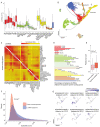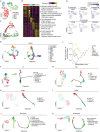Single-cell transcriptomic landscape of human blood cells
- PMID: 34691592
- PMCID: PMC8288407
- DOI: 10.1093/nsr/nwaa180
Single-cell transcriptomic landscape of human blood cells
Abstract
High throughput single-cell RNA-seq has been successfully implemented to dissect the cellular and molecular features underlying hematopoiesis. However, an elaborate and comprehensive transcriptome reference of the whole blood system is lacking. Here, we profiled the transcriptomes of 7551 human blood cells representing 32 immunophenotypic cell types, including hematopoietic stem cells, progenitors and mature blood cells derived from 21 healthy donors. With high sequencing depth and coverage, we constructed a single-cell transcriptional atlas of blood cells (ABC) on the basis of both protein-coding genes and long noncoding RNAs (lncRNAs), and showed a high consistence between them. Notably, putative lncRNAs and transcription factors regulating hematopoietic cell differentiation were identified. While common transcription factor regulatory networks were activated in neutrophils and monocytes, lymphoid cells dramatically changed their regulatory networks during differentiation. Furthermore, we showed a subset of nucleated erythrocytes actively expressing immune signals, suggesting the existence of erythroid precursors with immune functions. Finally, a web portal offering transcriptome browsing and blood cell type prediction has been established. Thus, our work provides a transcriptional map of human blood cells at single-cell resolution, thereby offering a comprehensive reference for the exploration of physiological and pathological hematopoiesis.
Keywords: hematopoietic cells; human; lncRNAs; single-cell RNA-seq; transcription factor.
© The Author(s) 2020. Published by Oxford University Press on behalf of China Science Publishing & Media Ltd.
Figures




References
LinkOut - more resources
Full Text Sources
Molecular Biology Databases
